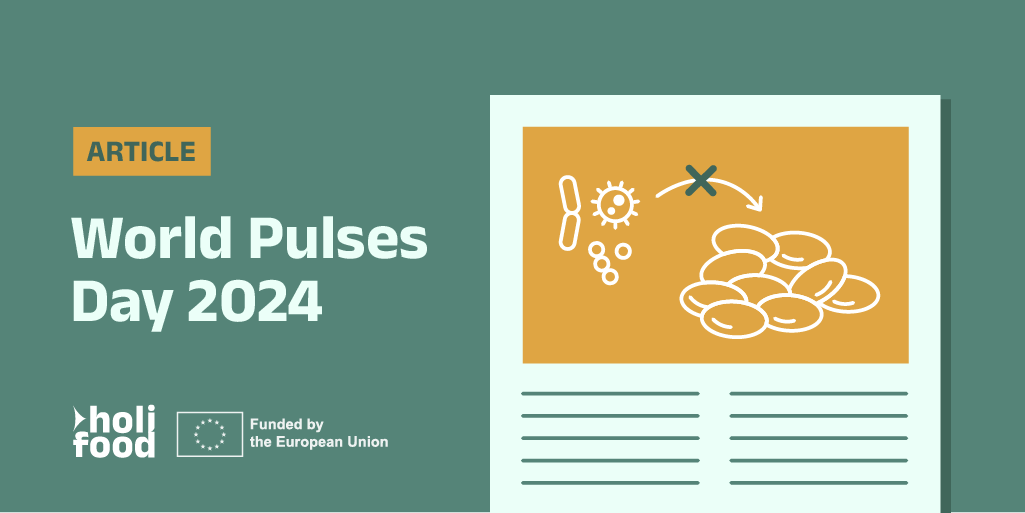World Pulses Day 2024: The power of legumes

Brussels, 9 January 2024
As stated by the Food and Agriculture Organisation (FAO), legumes play a fundamental role in the transformation to more efficient, inclusive, resilient and sustainable agrifood systems for better production, better nutrition, a better environment, and a better life. Their cultivation helps to optimize the use of fertilizers, with a huge impact on climate change mitigation. Moreover, legumes increase the feed conversion ratio while decreasing methane emissions from ruminants, thereby reducing greenhouse gas emissions and hence contributing to a Better Environment (1). Besides these huge benefits, some pathogens could contaminate legumes, posing a risk for human health.
To investigate the safety of legumes, researchers from the EU-funded project HOLiFOOD will develop new untargeted and targeted methods for the detection of foodborne pathogens in legumes.
The investigation will involve the Wageningen University (Netherland), the Institute of Sciences of Food Production of the National Research Council of Italy and nano-technology world-player IMEC (Netherland).
HOLiFOOD research
Wageningen Food Safety Research is refining an ad hoc method to extract and purify DNA of legumes. Once extracted and purified, DNA of legumes will be subjected to a “quasimetagenomic” approach, developed by the Wageningen University, that combines a selective enrichment with the next generation sequencing technology of metagenomics to detect foodborne pathogens in the legume chain. The emerging pathogens detected via this approach will be isolated from legume samples by the Institute of Sciences of Food Production of the National Research Council of Italy and subjected to DNA extraction and Whole-Genome Sequencing (WGS) so that their traits such as virulence, antibiotic resistance, etcetera, will be detected. Moreover, this methodology will allow the design of species and strain-specific primers that will be used to develop and validate quantitative PCR assays to achieve the real time quantitative detection of the targeted pathogens.
These novel protocols will be transferred to a portable microfluidic device, developed by IMEC, for the on-site and on-time quantitative detection of pathogens in legumes. Bacterial and viral persistence, defined as “repeated isolation of an indistinguishable isolate at sampling times greater than 6 months” (2), may provoke reiterated contamination of food with spoilage or pathogenic microorganisms tainting not only the quality but even the safety of the final products.
Recently this was demonstrated for some strains of Yersinia enterocolitica4/O:3 in pork products (3), Listeria monocytogenes and Escherichia coli O157:H7 on the exterior of three common food packaging materials (4), Listeria monocytogenes Serotype 4b Sequence Type 6 in cheese production environment (5) and so on. Similar behaviors could occur for other new pathogenic bacteria or even for the same old strains but in unexpected current and novel food matrices and environments.
CNR-ISPA, WU, and INRAE will significantly provide knowledge on the persistence of pathogens in legumes and relevant processing environment for improved microbe control.
References
Alvarez-Ordóñez A, Leong D, Morgan CA, Hill C, Gahan CG, Jordan K. Occurrence, persistence, and virulence potential of Listeria ivanovii in foods and food processing environments in the Republic of Ireland. Biomed Res Int. 2015;2015:350526. doi: 10.1155/2015/350526.
Kuruwita, D. P., Jiang, X., Darby, D., Sharp, J. L., & Fraser, A. M. (2020). Persistence of Escherichia coli O157:H7 and Listeria monocytogenes on the exterior of three common food packaging materials. Food Control, 112, Article 107153. https://doi.org/ 10.1016/j.foodcont.2020.107153.
Martins BTF, Azevedo EC, Yamatogi RS, Call DR, Nero LA. Persistence of Yersinia enterocolitica bio-serotype 4/O:3 in a pork production chain in Minas Gerais, Brazil. Food Microbiol. 2021 Apr;94:103660. doi: 10.1016/j.fm.2020.103660. Epub 2020 Oct 22. PMID: 33279085.
Nüesch-Inderbinen M, Bloemberg GV, Müller A, Stevens MJA, Cernela N, Kollöffel B, Stephan R. Listeriosis caused by persistence of Listeria monocytogenes Serotype 4b Sequence Type 6 in cheese production environment. Emerg Infect Dis. 2021 Jan;27(1):284-288. doi: 10.3201/eid2701.203266.




